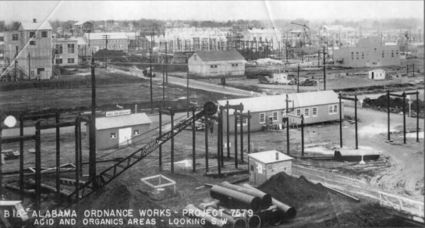Alabama Army Ammunition Plant
The Alabama Army Ammunition Plant (ALAAP, formerly called the Alabama Ordnance Works) was a United States munitions plant built and operated during World War II. The facility is located on the banks of the Coosa River, off Talladega County Highway 235 (Plant Road), just north of Childersburg in Talladega County.
The plant was constructed in 1941 on a 13,233-acre site to produce nitrocellulose (NC), trinitrotoluene (TNT), dinitrotoluene (DNT), tetryl, and single-base smokeless powder. The manufacturing plant, operated by DuPont, had a peak production rate of nearly 40 million pounds of munitions per month and employed as many as 14,000 full-time plant workers, with up to 9,000 more workers involved in construction. Many of those workers were housed in barracks on site, but the nearby towns of Childersburg and Sylacauga experienced enormous population booms during the war years. The employees of the plant published a weekly newspaper, entitled The Powder Wagon. Restaurateur John Proferis operated the employees' cafeteria until 1944.
Beginning in 1943 the plant also secretly produced deuterium-enriched "heavy water" for use in reactors being built for the "Manhattan Project" to develop atomic weapons. The distilling operation was referred to publicly as an ammonia plant.
All operations at the Ordnance Works ceased in August 1945. The plant was placed on standby status until 1973, when the Army declared it "excess property" and transferred all but 1,620 acres to the General Services Administration for redevelopment. A 1,354-acre parcel was sold in 1977 and developed as a paper mill, now operated by the Bowater Newsprint Corporation. Part of the site was used for the Childersburg Consolidated High School for African American students.
The U.S. Environmental Protection Agency placed the site on the National Priorities List (NPL) in 1987 due to the likelihood of soil contamination affecting sediments and groundwater. Between 1994 and 1997, the Army remediated about 120,000 cubic yards of soil that was found to have been contaminated.
A 2,187-acre parcel, including the section remediated by the Army, was turned over to the City of Childersburg in 2003 for industrial, commercial and recreational uses. Part of that site has been developed as the Coosa Industrial Park.
References
- Cronenberg, Allen (2003) Forth to the Mighty Conflict: Alabama and World War II. Tuscaloosa: University of Alabama Press ISBN 9780817350277
- "Alabama Army Ammunition Plant" (April 24, 2013) Wikipedia - accessed January 23, 2015
External links
- Alabama Army Ammunition Plant at epa.gov
